Human Resource Management - Solved Assignment
VerifiedAdded on 2021/06/14
|11
|3682
|29
AI Summary
Contribute Materials
Your contribution can guide someone’s learning journey. Share your
documents today.

Running head: Human resource management
Human resource management
Human resource management
Secure Best Marks with AI Grader
Need help grading? Try our AI Grader for instant feedback on your assignments.
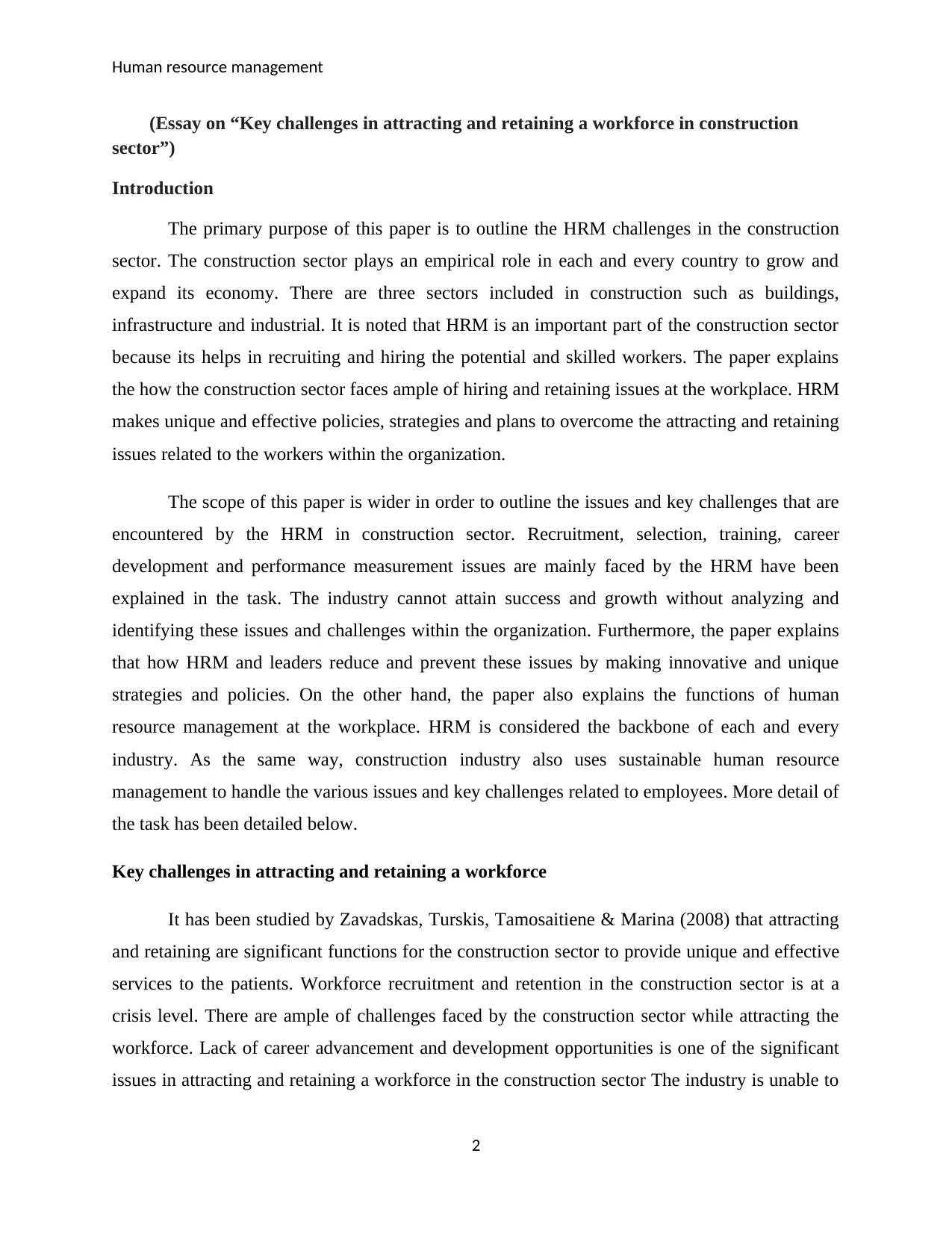
Human resource management
(Essay on “Key challenges in attracting and retaining a workforce in construction
sector”)
Introduction
The primary purpose of this paper is to outline the HRM challenges in the construction
sector. The construction sector plays an empirical role in each and every country to grow and
expand its economy. There are three sectors included in construction such as buildings,
infrastructure and industrial. It is noted that HRM is an important part of the construction sector
because its helps in recruiting and hiring the potential and skilled workers. The paper explains
the how the construction sector faces ample of hiring and retaining issues at the workplace. HRM
makes unique and effective policies, strategies and plans to overcome the attracting and retaining
issues related to the workers within the organization.
The scope of this paper is wider in order to outline the issues and key challenges that are
encountered by the HRM in construction sector. Recruitment, selection, training, career
development and performance measurement issues are mainly faced by the HRM have been
explained in the task. The industry cannot attain success and growth without analyzing and
identifying these issues and challenges within the organization. Furthermore, the paper explains
that how HRM and leaders reduce and prevent these issues by making innovative and unique
strategies and policies. On the other hand, the paper also explains the functions of human
resource management at the workplace. HRM is considered the backbone of each and every
industry. As the same way, construction industry also uses sustainable human resource
management to handle the various issues and key challenges related to employees. More detail of
the task has been detailed below.
Key challenges in attracting and retaining a workforce
It has been studied by Zavadskas, Turskis, Tamosaitiene & Marina (2008) that attracting
and retaining are significant functions for the construction sector to provide unique and effective
services to the patients. Workforce recruitment and retention in the construction sector is at a
crisis level. There are ample of challenges faced by the construction sector while attracting the
workforce. Lack of career advancement and development opportunities is one of the significant
issues in attracting and retaining a workforce in the construction sector The industry is unable to
2
(Essay on “Key challenges in attracting and retaining a workforce in construction
sector”)
Introduction
The primary purpose of this paper is to outline the HRM challenges in the construction
sector. The construction sector plays an empirical role in each and every country to grow and
expand its economy. There are three sectors included in construction such as buildings,
infrastructure and industrial. It is noted that HRM is an important part of the construction sector
because its helps in recruiting and hiring the potential and skilled workers. The paper explains
the how the construction sector faces ample of hiring and retaining issues at the workplace. HRM
makes unique and effective policies, strategies and plans to overcome the attracting and retaining
issues related to the workers within the organization.
The scope of this paper is wider in order to outline the issues and key challenges that are
encountered by the HRM in construction sector. Recruitment, selection, training, career
development and performance measurement issues are mainly faced by the HRM have been
explained in the task. The industry cannot attain success and growth without analyzing and
identifying these issues and challenges within the organization. Furthermore, the paper explains
that how HRM and leaders reduce and prevent these issues by making innovative and unique
strategies and policies. On the other hand, the paper also explains the functions of human
resource management at the workplace. HRM is considered the backbone of each and every
industry. As the same way, construction industry also uses sustainable human resource
management to handle the various issues and key challenges related to employees. More detail of
the task has been detailed below.
Key challenges in attracting and retaining a workforce
It has been studied by Zavadskas, Turskis, Tamosaitiene & Marina (2008) that attracting
and retaining are significant functions for the construction sector to provide unique and effective
services to the patients. Workforce recruitment and retention in the construction sector is at a
crisis level. There are ample of challenges faced by the construction sector while attracting the
workforce. Lack of career advancement and development opportunities is one of the significant
issues in attracting and retaining a workforce in the construction sector The industry is unable to
2
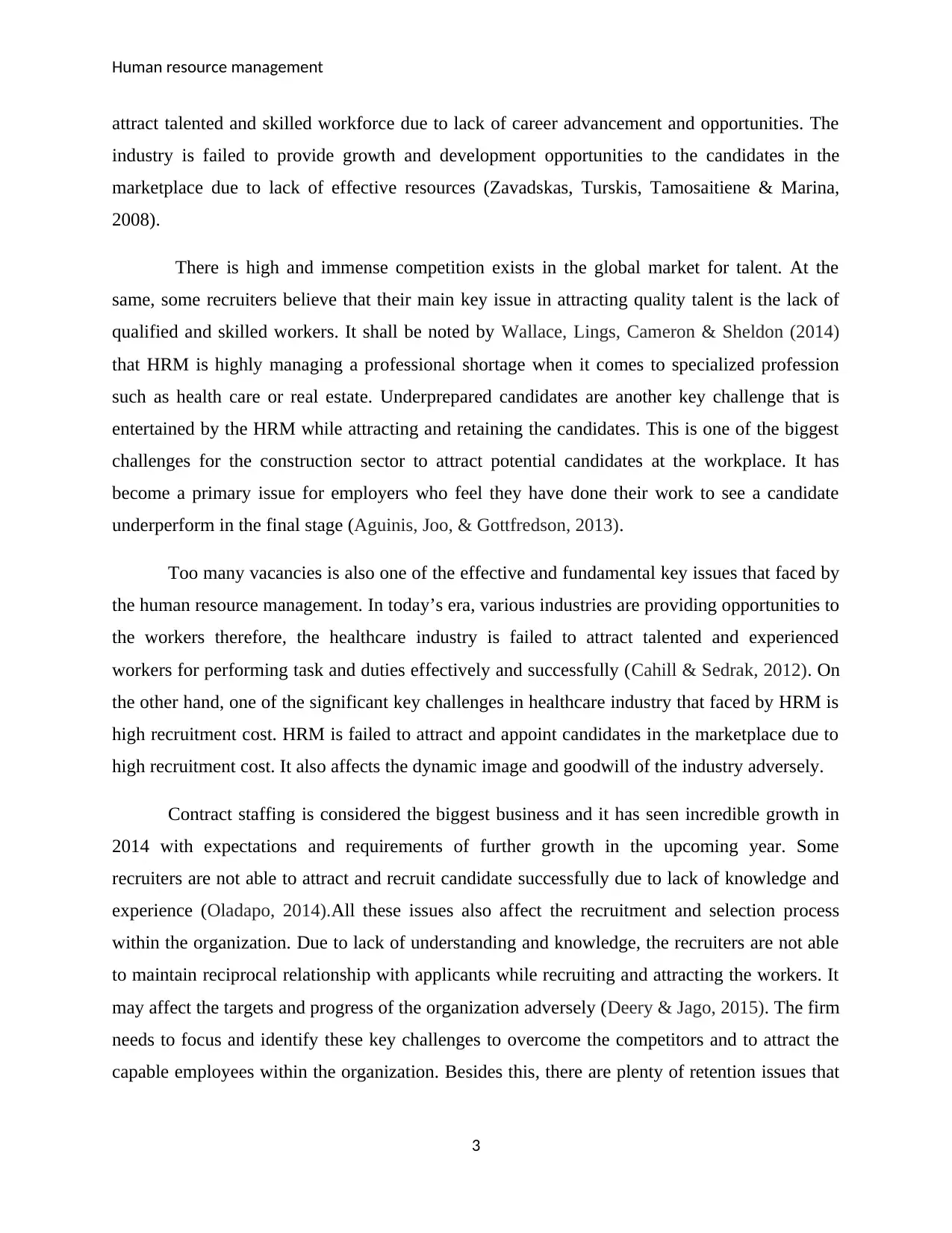
Human resource management
attract talented and skilled workforce due to lack of career advancement and opportunities. The
industry is failed to provide growth and development opportunities to the candidates in the
marketplace due to lack of effective resources (Zavadskas, Turskis, Tamosaitiene & Marina,
2008).
There is high and immense competition exists in the global market for talent. At the
same, some recruiters believe that their main key issue in attracting quality talent is the lack of
qualified and skilled workers. It shall be noted by Wallace, Lings, Cameron & Sheldon (2014)
that HRM is highly managing a professional shortage when it comes to specialized profession
such as health care or real estate. Underprepared candidates are another key challenge that is
entertained by the HRM while attracting and retaining the candidates. This is one of the biggest
challenges for the construction sector to attract potential candidates at the workplace. It has
become a primary issue for employers who feel they have done their work to see a candidate
underperform in the final stage (Aguinis, Joo, & Gottfredson, 2013).
Too many vacancies is also one of the effective and fundamental key issues that faced by
the human resource management. In today’s era, various industries are providing opportunities to
the workers therefore, the healthcare industry is failed to attract talented and experienced
workers for performing task and duties effectively and successfully (Cahill & Sedrak, 2012). On
the other hand, one of the significant key challenges in healthcare industry that faced by HRM is
high recruitment cost. HRM is failed to attract and appoint candidates in the marketplace due to
high recruitment cost. It also affects the dynamic image and goodwill of the industry adversely.
Contract staffing is considered the biggest business and it has seen incredible growth in
2014 with expectations and requirements of further growth in the upcoming year. Some
recruiters are not able to attract and recruit candidate successfully due to lack of knowledge and
experience (Oladapo, 2014).All these issues also affect the recruitment and selection process
within the organization. Due to lack of understanding and knowledge, the recruiters are not able
to maintain reciprocal relationship with applicants while recruiting and attracting the workers. It
may affect the targets and progress of the organization adversely (Deery & Jago, 2015). The firm
needs to focus and identify these key challenges to overcome the competitors and to attract the
capable employees within the organization. Besides this, there are plenty of retention issues that
3
attract talented and skilled workforce due to lack of career advancement and opportunities. The
industry is failed to provide growth and development opportunities to the candidates in the
marketplace due to lack of effective resources (Zavadskas, Turskis, Tamosaitiene & Marina,
2008).
There is high and immense competition exists in the global market for talent. At the
same, some recruiters believe that their main key issue in attracting quality talent is the lack of
qualified and skilled workers. It shall be noted by Wallace, Lings, Cameron & Sheldon (2014)
that HRM is highly managing a professional shortage when it comes to specialized profession
such as health care or real estate. Underprepared candidates are another key challenge that is
entertained by the HRM while attracting and retaining the candidates. This is one of the biggest
challenges for the construction sector to attract potential candidates at the workplace. It has
become a primary issue for employers who feel they have done their work to see a candidate
underperform in the final stage (Aguinis, Joo, & Gottfredson, 2013).
Too many vacancies is also one of the effective and fundamental key issues that faced by
the human resource management. In today’s era, various industries are providing opportunities to
the workers therefore, the healthcare industry is failed to attract talented and experienced
workers for performing task and duties effectively and successfully (Cahill & Sedrak, 2012). On
the other hand, one of the significant key challenges in healthcare industry that faced by HRM is
high recruitment cost. HRM is failed to attract and appoint candidates in the marketplace due to
high recruitment cost. It also affects the dynamic image and goodwill of the industry adversely.
Contract staffing is considered the biggest business and it has seen incredible growth in
2014 with expectations and requirements of further growth in the upcoming year. Some
recruiters are not able to attract and recruit candidate successfully due to lack of knowledge and
experience (Oladapo, 2014).All these issues also affect the recruitment and selection process
within the organization. Due to lack of understanding and knowledge, the recruiters are not able
to maintain reciprocal relationship with applicants while recruiting and attracting the workers. It
may affect the targets and progress of the organization adversely (Deery & Jago, 2015). The firm
needs to focus and identify these key challenges to overcome the competitors and to attract the
capable employees within the organization. Besides this, there are plenty of retention issues that
3
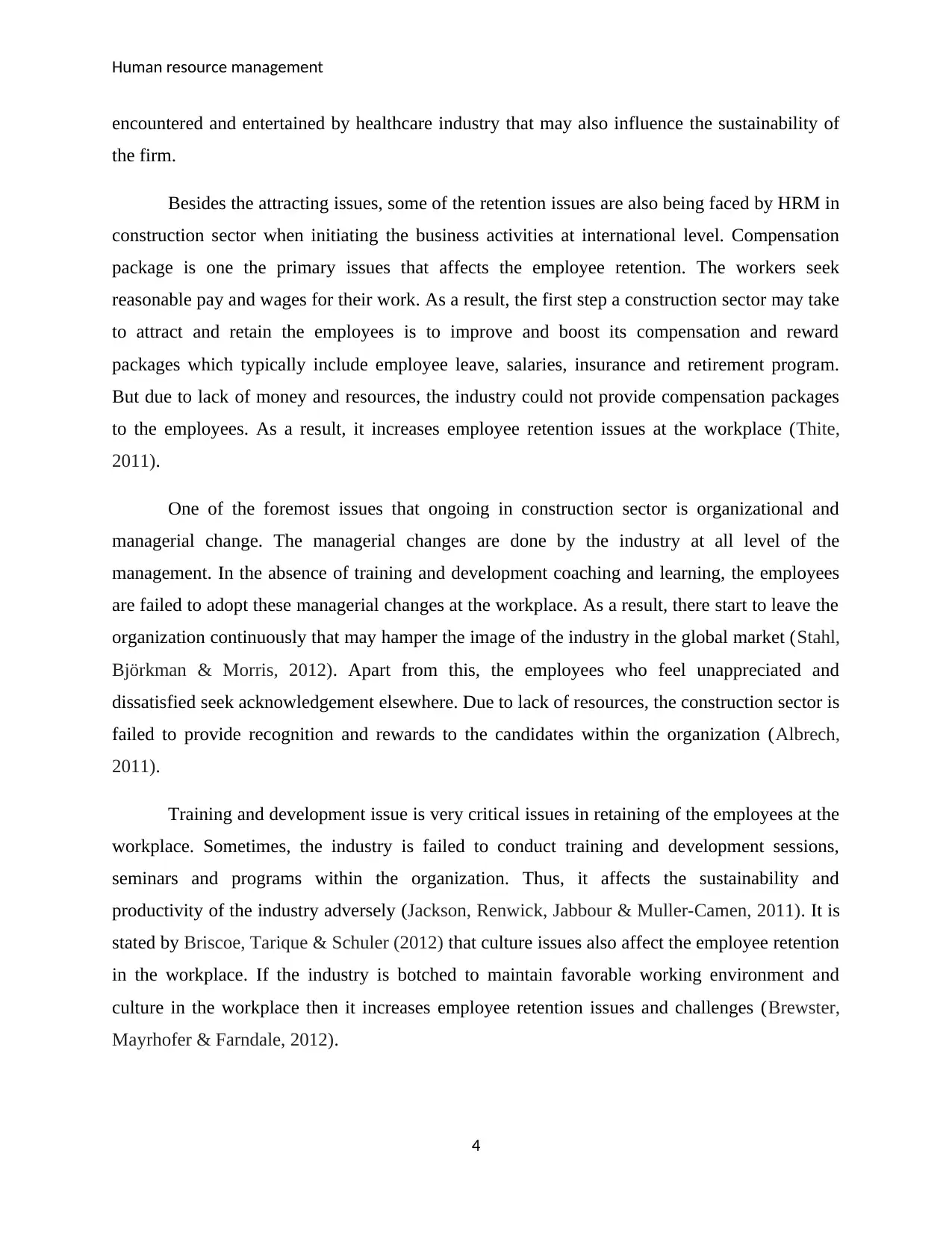
Human resource management
encountered and entertained by healthcare industry that may also influence the sustainability of
the firm.
Besides the attracting issues, some of the retention issues are also being faced by HRM in
construction sector when initiating the business activities at international level. Compensation
package is one the primary issues that affects the employee retention. The workers seek
reasonable pay and wages for their work. As a result, the first step a construction sector may take
to attract and retain the employees is to improve and boost its compensation and reward
packages which typically include employee leave, salaries, insurance and retirement program.
But due to lack of money and resources, the industry could not provide compensation packages
to the employees. As a result, it increases employee retention issues at the workplace (Thite,
2011).
One of the foremost issues that ongoing in construction sector is organizational and
managerial change. The managerial changes are done by the industry at all level of the
management. In the absence of training and development coaching and learning, the employees
are failed to adopt these managerial changes at the workplace. As a result, there start to leave the
organization continuously that may hamper the image of the industry in the global market (Stahl,
Björkman & Morris, 2012). Apart from this, the employees who feel unappreciated and
dissatisfied seek acknowledgement elsewhere. Due to lack of resources, the construction sector is
failed to provide recognition and rewards to the candidates within the organization (Albrech,
2011).
Training and development issue is very critical issues in retaining of the employees at the
workplace. Sometimes, the industry is failed to conduct training and development sessions,
seminars and programs within the organization. Thus, it affects the sustainability and
productivity of the industry adversely (Jackson, Renwick, Jabbour & Muller-Camen, 2011). It is
stated by Briscoe, Tarique & Schuler (2012) that culture issues also affect the employee retention
in the workplace. If the industry is botched to maintain favorable working environment and
culture in the workplace then it increases employee retention issues and challenges (Brewster,
Mayrhofer & Farndale, 2012).
4
encountered and entertained by healthcare industry that may also influence the sustainability of
the firm.
Besides the attracting issues, some of the retention issues are also being faced by HRM in
construction sector when initiating the business activities at international level. Compensation
package is one the primary issues that affects the employee retention. The workers seek
reasonable pay and wages for their work. As a result, the first step a construction sector may take
to attract and retain the employees is to improve and boost its compensation and reward
packages which typically include employee leave, salaries, insurance and retirement program.
But due to lack of money and resources, the industry could not provide compensation packages
to the employees. As a result, it increases employee retention issues at the workplace (Thite,
2011).
One of the foremost issues that ongoing in construction sector is organizational and
managerial change. The managerial changes are done by the industry at all level of the
management. In the absence of training and development coaching and learning, the employees
are failed to adopt these managerial changes at the workplace. As a result, there start to leave the
organization continuously that may hamper the image of the industry in the global market (Stahl,
Björkman & Morris, 2012). Apart from this, the employees who feel unappreciated and
dissatisfied seek acknowledgement elsewhere. Due to lack of resources, the construction sector is
failed to provide recognition and rewards to the candidates within the organization (Albrech,
2011).
Training and development issue is very critical issues in retaining of the employees at the
workplace. Sometimes, the industry is failed to conduct training and development sessions,
seminars and programs within the organization. Thus, it affects the sustainability and
productivity of the industry adversely (Jackson, Renwick, Jabbour & Muller-Camen, 2011). It is
stated by Briscoe, Tarique & Schuler (2012) that culture issues also affect the employee retention
in the workplace. If the industry is botched to maintain favorable working environment and
culture in the workplace then it increases employee retention issues and challenges (Brewster,
Mayrhofer & Farndale, 2012).
4
Secure Best Marks with AI Grader
Need help grading? Try our AI Grader for instant feedback on your assignments.
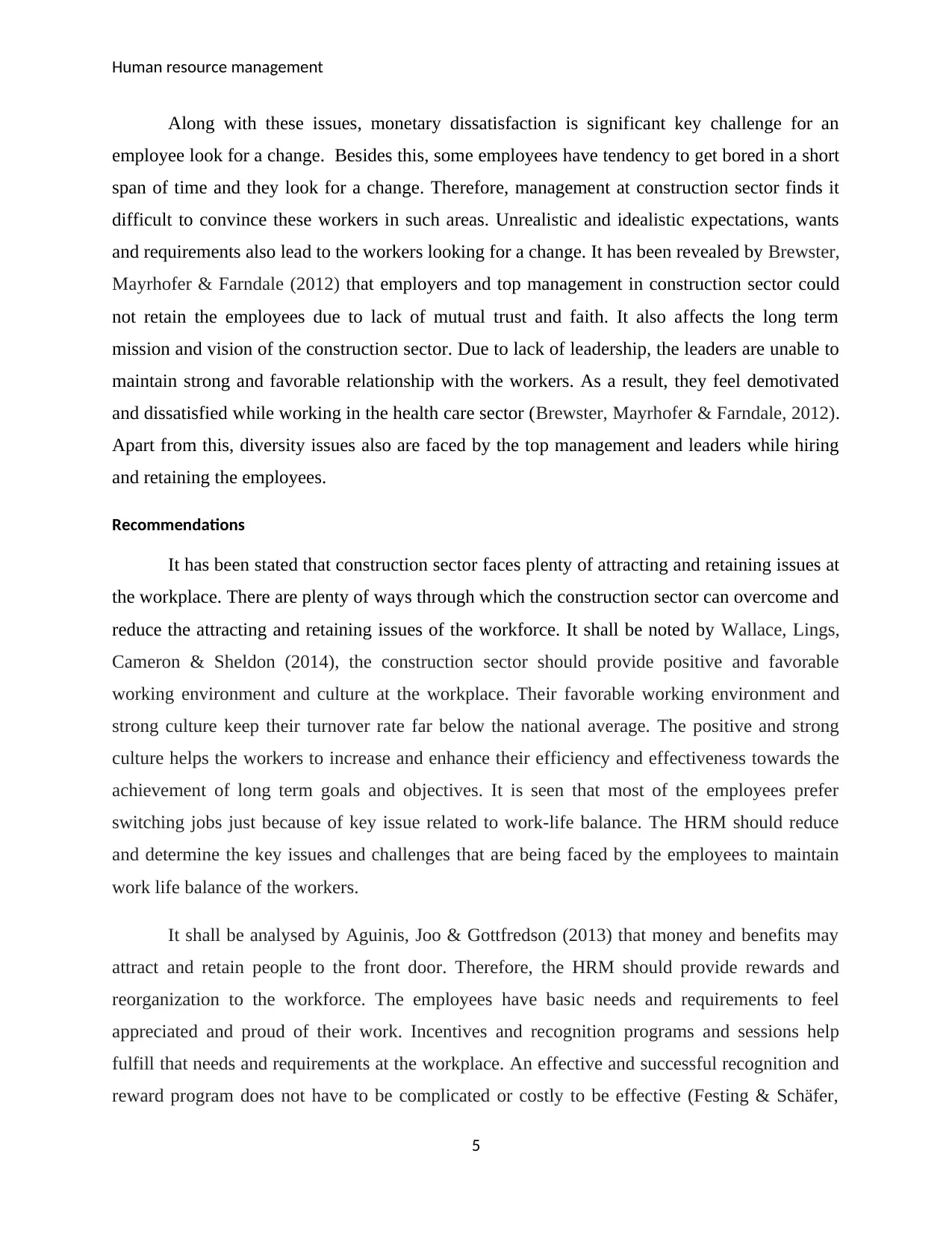
Human resource management
Along with these issues, monetary dissatisfaction is significant key challenge for an
employee look for a change. Besides this, some employees have tendency to get bored in a short
span of time and they look for a change. Therefore, management at construction sector finds it
difficult to convince these workers in such areas. Unrealistic and idealistic expectations, wants
and requirements also lead to the workers looking for a change. It has been revealed by Brewster,
Mayrhofer & Farndale (2012) that employers and top management in construction sector could
not retain the employees due to lack of mutual trust and faith. It also affects the long term
mission and vision of the construction sector. Due to lack of leadership, the leaders are unable to
maintain strong and favorable relationship with the workers. As a result, they feel demotivated
and dissatisfied while working in the health care sector (Brewster, Mayrhofer & Farndale, 2012).
Apart from this, diversity issues also are faced by the top management and leaders while hiring
and retaining the employees.
Recommendations
It has been stated that construction sector faces plenty of attracting and retaining issues at
the workplace. There are plenty of ways through which the construction sector can overcome and
reduce the attracting and retaining issues of the workforce. It shall be noted by Wallace, Lings,
Cameron & Sheldon (2014), the construction sector should provide positive and favorable
working environment and culture at the workplace. Their favorable working environment and
strong culture keep their turnover rate far below the national average. The positive and strong
culture helps the workers to increase and enhance their efficiency and effectiveness towards the
achievement of long term goals and objectives. It is seen that most of the employees prefer
switching jobs just because of key issue related to work-life balance. The HRM should reduce
and determine the key issues and challenges that are being faced by the employees to maintain
work life balance of the workers.
It shall be analysed by Aguinis, Joo & Gottfredson (2013) that money and benefits may
attract and retain people to the front door. Therefore, the HRM should provide rewards and
reorganization to the workforce. The employees have basic needs and requirements to feel
appreciated and proud of their work. Incentives and recognition programs and sessions help
fulfill that needs and requirements at the workplace. An effective and successful recognition and
reward program does not have to be complicated or costly to be effective (Festing & Schäfer,
5
Along with these issues, monetary dissatisfaction is significant key challenge for an
employee look for a change. Besides this, some employees have tendency to get bored in a short
span of time and they look for a change. Therefore, management at construction sector finds it
difficult to convince these workers in such areas. Unrealistic and idealistic expectations, wants
and requirements also lead to the workers looking for a change. It has been revealed by Brewster,
Mayrhofer & Farndale (2012) that employers and top management in construction sector could
not retain the employees due to lack of mutual trust and faith. It also affects the long term
mission and vision of the construction sector. Due to lack of leadership, the leaders are unable to
maintain strong and favorable relationship with the workers. As a result, they feel demotivated
and dissatisfied while working in the health care sector (Brewster, Mayrhofer & Farndale, 2012).
Apart from this, diversity issues also are faced by the top management and leaders while hiring
and retaining the employees.
Recommendations
It has been stated that construction sector faces plenty of attracting and retaining issues at
the workplace. There are plenty of ways through which the construction sector can overcome and
reduce the attracting and retaining issues of the workforce. It shall be noted by Wallace, Lings,
Cameron & Sheldon (2014), the construction sector should provide positive and favorable
working environment and culture at the workplace. Their favorable working environment and
strong culture keep their turnover rate far below the national average. The positive and strong
culture helps the workers to increase and enhance their efficiency and effectiveness towards the
achievement of long term goals and objectives. It is seen that most of the employees prefer
switching jobs just because of key issue related to work-life balance. The HRM should reduce
and determine the key issues and challenges that are being faced by the employees to maintain
work life balance of the workers.
It shall be analysed by Aguinis, Joo & Gottfredson (2013) that money and benefits may
attract and retain people to the front door. Therefore, the HRM should provide rewards and
reorganization to the workforce. The employees have basic needs and requirements to feel
appreciated and proud of their work. Incentives and recognition programs and sessions help
fulfill that needs and requirements at the workplace. An effective and successful recognition and
reward program does not have to be complicated or costly to be effective (Festing & Schäfer,
5
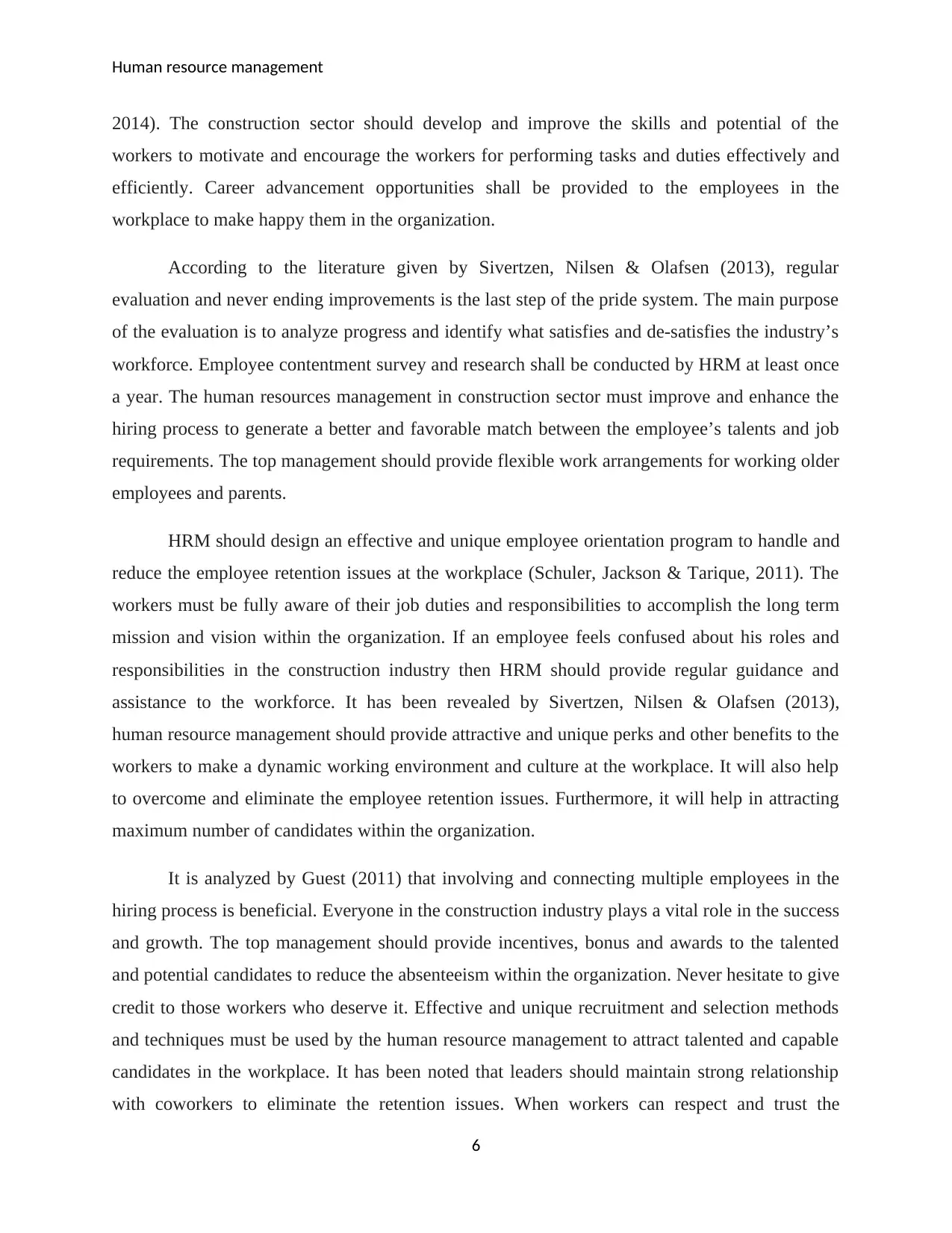
Human resource management
2014). The construction sector should develop and improve the skills and potential of the
workers to motivate and encourage the workers for performing tasks and duties effectively and
efficiently. Career advancement opportunities shall be provided to the employees in the
workplace to make happy them in the organization.
According to the literature given by Sivertzen, Nilsen & Olafsen (2013), regular
evaluation and never ending improvements is the last step of the pride system. The main purpose
of the evaluation is to analyze progress and identify what satisfies and de-satisfies the industry’s
workforce. Employee contentment survey and research shall be conducted by HRM at least once
a year. The human resources management in construction sector must improve and enhance the
hiring process to generate a better and favorable match between the employee’s talents and job
requirements. The top management should provide flexible work arrangements for working older
employees and parents.
HRM should design an effective and unique employee orientation program to handle and
reduce the employee retention issues at the workplace (Schuler, Jackson & Tarique, 2011). The
workers must be fully aware of their job duties and responsibilities to accomplish the long term
mission and vision within the organization. If an employee feels confused about his roles and
responsibilities in the construction industry then HRM should provide regular guidance and
assistance to the workforce. It has been revealed by Sivertzen, Nilsen & Olafsen (2013),
human resource management should provide attractive and unique perks and other benefits to the
workers to make a dynamic working environment and culture at the workplace. It will also help
to overcome and eliminate the employee retention issues. Furthermore, it will help in attracting
maximum number of candidates within the organization.
It is analyzed by Guest (2011) that involving and connecting multiple employees in the
hiring process is beneficial. Everyone in the construction industry plays a vital role in the success
and growth. The top management should provide incentives, bonus and awards to the talented
and potential candidates to reduce the absenteeism within the organization. Never hesitate to give
credit to those workers who deserve it. Effective and unique recruitment and selection methods
and techniques must be used by the human resource management to attract talented and capable
candidates in the workplace. It has been noted that leaders should maintain strong relationship
with coworkers to eliminate the retention issues. When workers can respect and trust the
6
2014). The construction sector should develop and improve the skills and potential of the
workers to motivate and encourage the workers for performing tasks and duties effectively and
efficiently. Career advancement opportunities shall be provided to the employees in the
workplace to make happy them in the organization.
According to the literature given by Sivertzen, Nilsen & Olafsen (2013), regular
evaluation and never ending improvements is the last step of the pride system. The main purpose
of the evaluation is to analyze progress and identify what satisfies and de-satisfies the industry’s
workforce. Employee contentment survey and research shall be conducted by HRM at least once
a year. The human resources management in construction sector must improve and enhance the
hiring process to generate a better and favorable match between the employee’s talents and job
requirements. The top management should provide flexible work arrangements for working older
employees and parents.
HRM should design an effective and unique employee orientation program to handle and
reduce the employee retention issues at the workplace (Schuler, Jackson & Tarique, 2011). The
workers must be fully aware of their job duties and responsibilities to accomplish the long term
mission and vision within the organization. If an employee feels confused about his roles and
responsibilities in the construction industry then HRM should provide regular guidance and
assistance to the workforce. It has been revealed by Sivertzen, Nilsen & Olafsen (2013),
human resource management should provide attractive and unique perks and other benefits to the
workers to make a dynamic working environment and culture at the workplace. It will also help
to overcome and eliminate the employee retention issues. Furthermore, it will help in attracting
maximum number of candidates within the organization.
It is analyzed by Guest (2011) that involving and connecting multiple employees in the
hiring process is beneficial. Everyone in the construction industry plays a vital role in the success
and growth. The top management should provide incentives, bonus and awards to the talented
and potential candidates to reduce the absenteeism within the organization. Never hesitate to give
credit to those workers who deserve it. Effective and unique recruitment and selection methods
and techniques must be used by the human resource management to attract talented and capable
candidates in the workplace. It has been noted that leaders should maintain strong relationship
with coworkers to eliminate the retention issues. When workers can respect and trust the
6
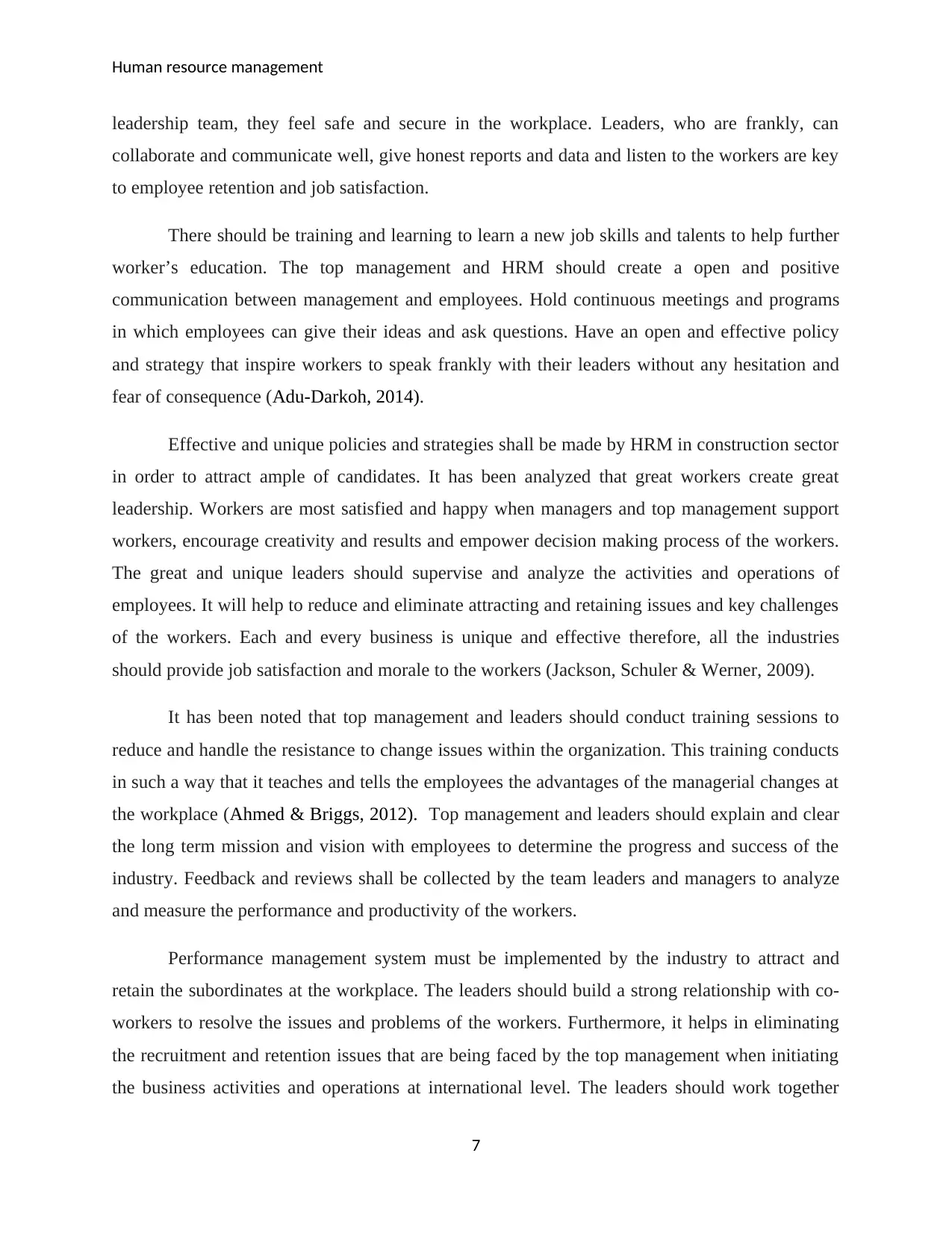
Human resource management
leadership team, they feel safe and secure in the workplace. Leaders, who are frankly, can
collaborate and communicate well, give honest reports and data and listen to the workers are key
to employee retention and job satisfaction.
There should be training and learning to learn a new job skills and talents to help further
worker’s education. The top management and HRM should create a open and positive
communication between management and employees. Hold continuous meetings and programs
in which employees can give their ideas and ask questions. Have an open and effective policy
and strategy that inspire workers to speak frankly with their leaders without any hesitation and
fear of consequence (Adu-Darkoh, 2014).
Effective and unique policies and strategies shall be made by HRM in construction sector
in order to attract ample of candidates. It has been analyzed that great workers create great
leadership. Workers are most satisfied and happy when managers and top management support
workers, encourage creativity and results and empower decision making process of the workers.
The great and unique leaders should supervise and analyze the activities and operations of
employees. It will help to reduce and eliminate attracting and retaining issues and key challenges
of the workers. Each and every business is unique and effective therefore, all the industries
should provide job satisfaction and morale to the workers (Jackson, Schuler & Werner, 2009).
It has been noted that top management and leaders should conduct training sessions to
reduce and handle the resistance to change issues within the organization. This training conducts
in such a way that it teaches and tells the employees the advantages of the managerial changes at
the workplace (Ahmed & Briggs, 2012). Top management and leaders should explain and clear
the long term mission and vision with employees to determine the progress and success of the
industry. Feedback and reviews shall be collected by the team leaders and managers to analyze
and measure the performance and productivity of the workers.
Performance management system must be implemented by the industry to attract and
retain the subordinates at the workplace. The leaders should build a strong relationship with co-
workers to resolve the issues and problems of the workers. Furthermore, it helps in eliminating
the recruitment and retention issues that are being faced by the top management when initiating
the business activities and operations at international level. The leaders should work together
7
leadership team, they feel safe and secure in the workplace. Leaders, who are frankly, can
collaborate and communicate well, give honest reports and data and listen to the workers are key
to employee retention and job satisfaction.
There should be training and learning to learn a new job skills and talents to help further
worker’s education. The top management and HRM should create a open and positive
communication between management and employees. Hold continuous meetings and programs
in which employees can give their ideas and ask questions. Have an open and effective policy
and strategy that inspire workers to speak frankly with their leaders without any hesitation and
fear of consequence (Adu-Darkoh, 2014).
Effective and unique policies and strategies shall be made by HRM in construction sector
in order to attract ample of candidates. It has been analyzed that great workers create great
leadership. Workers are most satisfied and happy when managers and top management support
workers, encourage creativity and results and empower decision making process of the workers.
The great and unique leaders should supervise and analyze the activities and operations of
employees. It will help to reduce and eliminate attracting and retaining issues and key challenges
of the workers. Each and every business is unique and effective therefore, all the industries
should provide job satisfaction and morale to the workers (Jackson, Schuler & Werner, 2009).
It has been noted that top management and leaders should conduct training sessions to
reduce and handle the resistance to change issues within the organization. This training conducts
in such a way that it teaches and tells the employees the advantages of the managerial changes at
the workplace (Ahmed & Briggs, 2012). Top management and leaders should explain and clear
the long term mission and vision with employees to determine the progress and success of the
industry. Feedback and reviews shall be collected by the team leaders and managers to analyze
and measure the performance and productivity of the workers.
Performance management system must be implemented by the industry to attract and
retain the subordinates at the workplace. The leaders should build a strong relationship with co-
workers to resolve the issues and problems of the workers. Furthermore, it helps in eliminating
the recruitment and retention issues that are being faced by the top management when initiating
the business activities and operations at international level. The leaders should work together
7
Paraphrase This Document
Need a fresh take? Get an instant paraphrase of this document with our AI Paraphraser
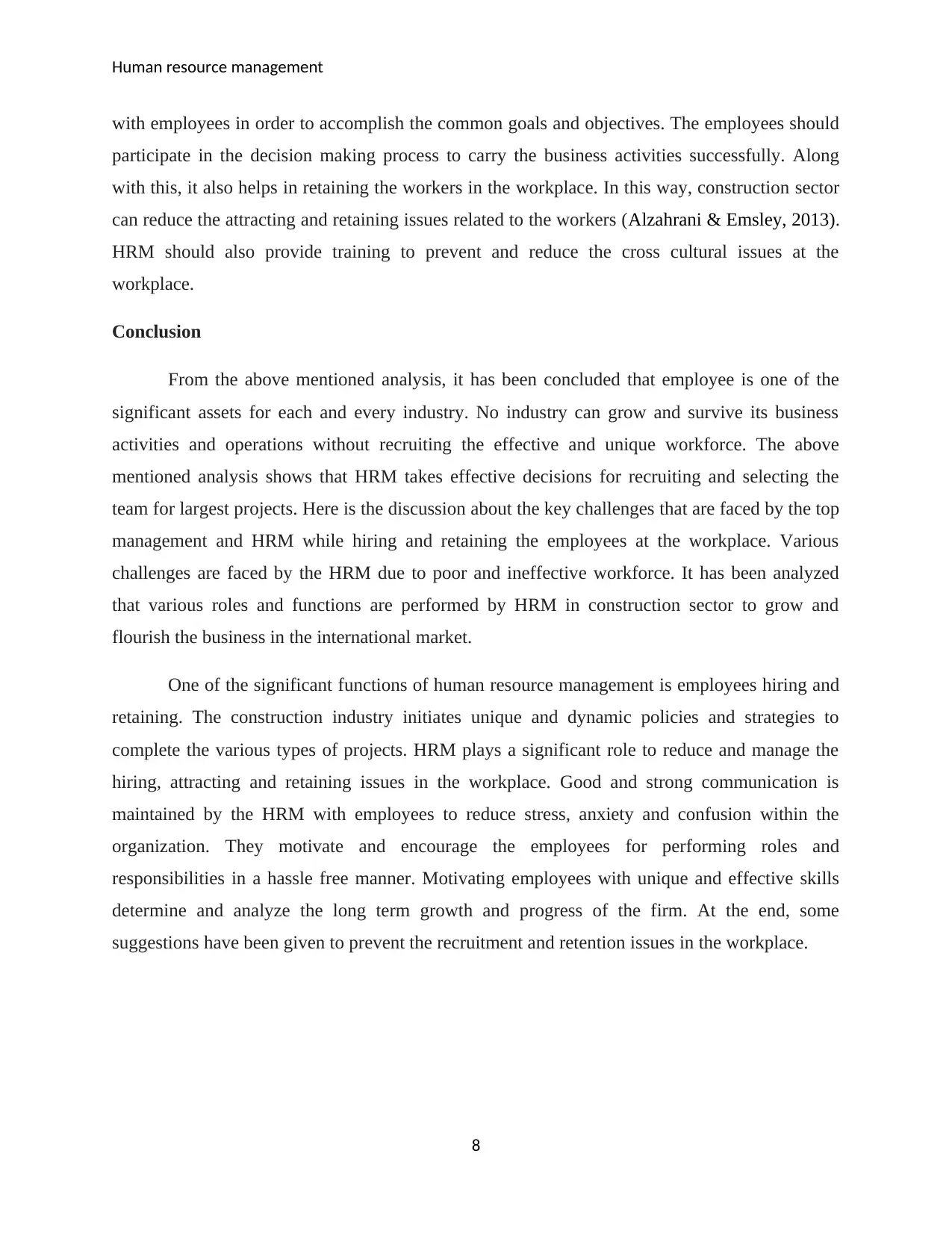
Human resource management
with employees in order to accomplish the common goals and objectives. The employees should
participate in the decision making process to carry the business activities successfully. Along
with this, it also helps in retaining the workers in the workplace. In this way, construction sector
can reduce the attracting and retaining issues related to the workers (Alzahrani & Emsley, 2013).
HRM should also provide training to prevent and reduce the cross cultural issues at the
workplace.
Conclusion
From the above mentioned analysis, it has been concluded that employee is one of the
significant assets for each and every industry. No industry can grow and survive its business
activities and operations without recruiting the effective and unique workforce. The above
mentioned analysis shows that HRM takes effective decisions for recruiting and selecting the
team for largest projects. Here is the discussion about the key challenges that are faced by the top
management and HRM while hiring and retaining the employees at the workplace. Various
challenges are faced by the HRM due to poor and ineffective workforce. It has been analyzed
that various roles and functions are performed by HRM in construction sector to grow and
flourish the business in the international market.
One of the significant functions of human resource management is employees hiring and
retaining. The construction industry initiates unique and dynamic policies and strategies to
complete the various types of projects. HRM plays a significant role to reduce and manage the
hiring, attracting and retaining issues in the workplace. Good and strong communication is
maintained by the HRM with employees to reduce stress, anxiety and confusion within the
organization. They motivate and encourage the employees for performing roles and
responsibilities in a hassle free manner. Motivating employees with unique and effective skills
determine and analyze the long term growth and progress of the firm. At the end, some
suggestions have been given to prevent the recruitment and retention issues in the workplace.
8
with employees in order to accomplish the common goals and objectives. The employees should
participate in the decision making process to carry the business activities successfully. Along
with this, it also helps in retaining the workers in the workplace. In this way, construction sector
can reduce the attracting and retaining issues related to the workers (Alzahrani & Emsley, 2013).
HRM should also provide training to prevent and reduce the cross cultural issues at the
workplace.
Conclusion
From the above mentioned analysis, it has been concluded that employee is one of the
significant assets for each and every industry. No industry can grow and survive its business
activities and operations without recruiting the effective and unique workforce. The above
mentioned analysis shows that HRM takes effective decisions for recruiting and selecting the
team for largest projects. Here is the discussion about the key challenges that are faced by the top
management and HRM while hiring and retaining the employees at the workplace. Various
challenges are faced by the HRM due to poor and ineffective workforce. It has been analyzed
that various roles and functions are performed by HRM in construction sector to grow and
flourish the business in the international market.
One of the significant functions of human resource management is employees hiring and
retaining. The construction industry initiates unique and dynamic policies and strategies to
complete the various types of projects. HRM plays a significant role to reduce and manage the
hiring, attracting and retaining issues in the workplace. Good and strong communication is
maintained by the HRM with employees to reduce stress, anxiety and confusion within the
organization. They motivate and encourage the employees for performing roles and
responsibilities in a hassle free manner. Motivating employees with unique and effective skills
determine and analyze the long term growth and progress of the firm. At the end, some
suggestions have been given to prevent the recruitment and retention issues in the workplace.
8

Human resource management
References
Adu-Darkoh, M. (2014). Employee recruitment and selection practices in the construction
industry in Ashanti Region, pp.62-63
Aguinis, H., Joo, H., & Gottfredson, R. K. (2013). What monetary rewards can and cannot do:
How to show employees the money. Business Horizons, 56(2), pp.241-249.
Ahmed, S., & Briggs, K. (2012). Effective recruitment and selection strategies for skilled
laborers in heavy highway construction, pp.333-335.
Albrech, S. L. (2011). Handbook of employee engagement: Perspectives, issues, research and
practice. Human Resource Management International Digest, 19(7).
Alzahrani, J. I., & Emsley, M. W. (2013). The impact of contractors’ attributes on construction
project success: A post construction evaluation. International Journal of Project
Management, 31(2), 313-322.
Brewster, C., Mayrhofer, W., & Farndale, E. (Eds.). (2012). Handbook of research on
comparative human resource management. Edward Elgar Publishing.
Briscoe, D., Tarique, I., & Schuler, R. (2012). International human resource management:
Policies and practices for multinational enterprises. Routledge.
Cahill, T. F., & Sedrak, M. (2012). Leading a multigenerational workforce: Strategies for
attracting and retaining millennials. Frontiers of Health Services Management, 29(1), 3-
15.
Deery, M., & Jago, L. (2015). Revisiting talent management, work-life balance and retention
strategies. International Journal of Contemporary Hospitality Management, 27(3), 453-
472.
9
References
Adu-Darkoh, M. (2014). Employee recruitment and selection practices in the construction
industry in Ashanti Region, pp.62-63
Aguinis, H., Joo, H., & Gottfredson, R. K. (2013). What monetary rewards can and cannot do:
How to show employees the money. Business Horizons, 56(2), pp.241-249.
Ahmed, S., & Briggs, K. (2012). Effective recruitment and selection strategies for skilled
laborers in heavy highway construction, pp.333-335.
Albrech, S. L. (2011). Handbook of employee engagement: Perspectives, issues, research and
practice. Human Resource Management International Digest, 19(7).
Alzahrani, J. I., & Emsley, M. W. (2013). The impact of contractors’ attributes on construction
project success: A post construction evaluation. International Journal of Project
Management, 31(2), 313-322.
Brewster, C., Mayrhofer, W., & Farndale, E. (Eds.). (2012). Handbook of research on
comparative human resource management. Edward Elgar Publishing.
Briscoe, D., Tarique, I., & Schuler, R. (2012). International human resource management:
Policies and practices for multinational enterprises. Routledge.
Cahill, T. F., & Sedrak, M. (2012). Leading a multigenerational workforce: Strategies for
attracting and retaining millennials. Frontiers of Health Services Management, 29(1), 3-
15.
Deery, M., & Jago, L. (2015). Revisiting talent management, work-life balance and retention
strategies. International Journal of Contemporary Hospitality Management, 27(3), 453-
472.
9
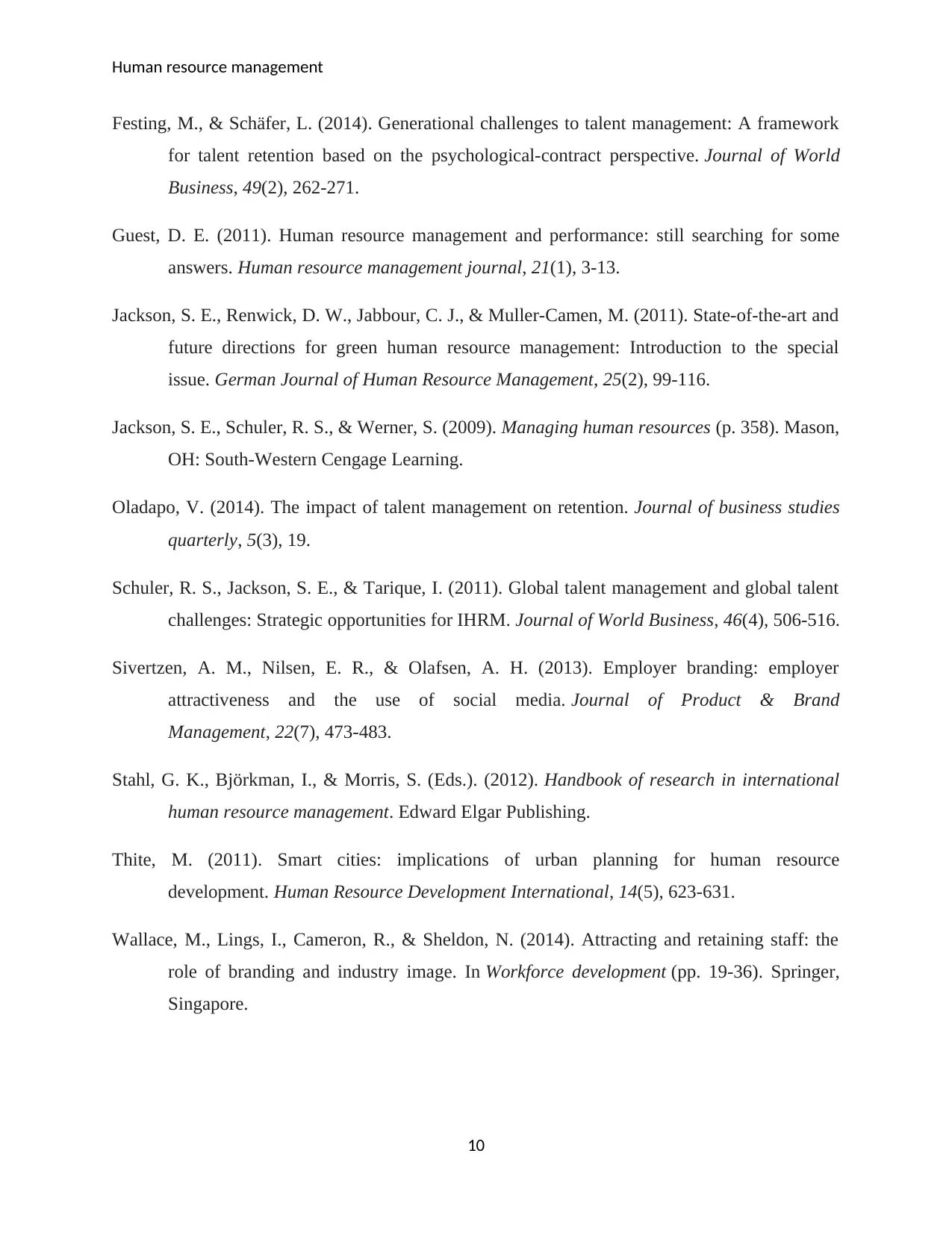
Human resource management
Festing, M., & Schäfer, L. (2014). Generational challenges to talent management: A framework
for talent retention based on the psychological-contract perspective. Journal of World
Business, 49(2), 262-271.
Guest, D. E. (2011). Human resource management and performance: still searching for some
answers. Human resource management journal, 21(1), 3-13.
Jackson, S. E., Renwick, D. W., Jabbour, C. J., & Muller-Camen, M. (2011). State-of-the-art and
future directions for green human resource management: Introduction to the special
issue. German Journal of Human Resource Management, 25(2), 99-116.
Jackson, S. E., Schuler, R. S., & Werner, S. (2009). Managing human resources (p. 358). Mason,
OH: South-Western Cengage Learning.
Oladapo, V. (2014). The impact of talent management on retention. Journal of business studies
quarterly, 5(3), 19.
Schuler, R. S., Jackson, S. E., & Tarique, I. (2011). Global talent management and global talent
challenges: Strategic opportunities for IHRM. Journal of World Business, 46(4), 506-516.
Sivertzen, A. M., Nilsen, E. R., & Olafsen, A. H. (2013). Employer branding: employer
attractiveness and the use of social media. Journal of Product & Brand
Management, 22(7), 473-483.
Stahl, G. K., Björkman, I., & Morris, S. (Eds.). (2012). Handbook of research in international
human resource management. Edward Elgar Publishing.
Thite, M. (2011). Smart cities: implications of urban planning for human resource
development. Human Resource Development International, 14(5), 623-631.
Wallace, M., Lings, I., Cameron, R., & Sheldon, N. (2014). Attracting and retaining staff: the
role of branding and industry image. In Workforce development (pp. 19-36). Springer,
Singapore.
10
Festing, M., & Schäfer, L. (2014). Generational challenges to talent management: A framework
for talent retention based on the psychological-contract perspective. Journal of World
Business, 49(2), 262-271.
Guest, D. E. (2011). Human resource management and performance: still searching for some
answers. Human resource management journal, 21(1), 3-13.
Jackson, S. E., Renwick, D. W., Jabbour, C. J., & Muller-Camen, M. (2011). State-of-the-art and
future directions for green human resource management: Introduction to the special
issue. German Journal of Human Resource Management, 25(2), 99-116.
Jackson, S. E., Schuler, R. S., & Werner, S. (2009). Managing human resources (p. 358). Mason,
OH: South-Western Cengage Learning.
Oladapo, V. (2014). The impact of talent management on retention. Journal of business studies
quarterly, 5(3), 19.
Schuler, R. S., Jackson, S. E., & Tarique, I. (2011). Global talent management and global talent
challenges: Strategic opportunities for IHRM. Journal of World Business, 46(4), 506-516.
Sivertzen, A. M., Nilsen, E. R., & Olafsen, A. H. (2013). Employer branding: employer
attractiveness and the use of social media. Journal of Product & Brand
Management, 22(7), 473-483.
Stahl, G. K., Björkman, I., & Morris, S. (Eds.). (2012). Handbook of research in international
human resource management. Edward Elgar Publishing.
Thite, M. (2011). Smart cities: implications of urban planning for human resource
development. Human Resource Development International, 14(5), 623-631.
Wallace, M., Lings, I., Cameron, R., & Sheldon, N. (2014). Attracting and retaining staff: the
role of branding and industry image. In Workforce development (pp. 19-36). Springer,
Singapore.
10
Secure Best Marks with AI Grader
Need help grading? Try our AI Grader for instant feedback on your assignments.
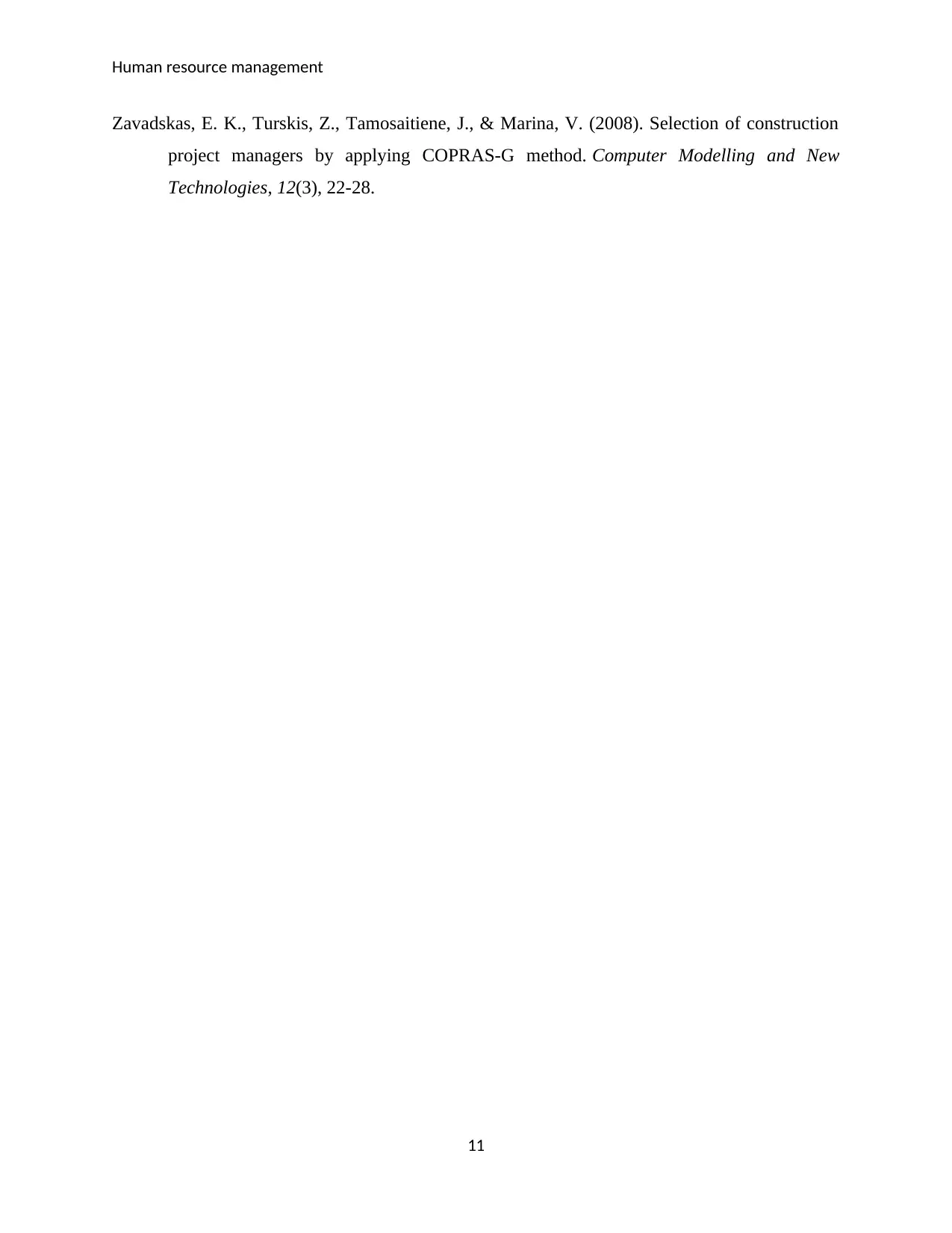
Human resource management
Zavadskas, E. K., Turskis, Z., Tamosaitiene, J., & Marina, V. (2008). Selection of construction
project managers by applying COPRAS-G method. Computer Modelling and New
Technologies, 12(3), 22-28.
11
Zavadskas, E. K., Turskis, Z., Tamosaitiene, J., & Marina, V. (2008). Selection of construction
project managers by applying COPRAS-G method. Computer Modelling and New
Technologies, 12(3), 22-28.
11
1 out of 11
Related Documents
Your All-in-One AI-Powered Toolkit for Academic Success.
+13062052269
info@desklib.com
Available 24*7 on WhatsApp / Email
![[object Object]](/_next/static/media/star-bottom.7253800d.svg)
Unlock your academic potential
© 2024 | Zucol Services PVT LTD | All rights reserved.



